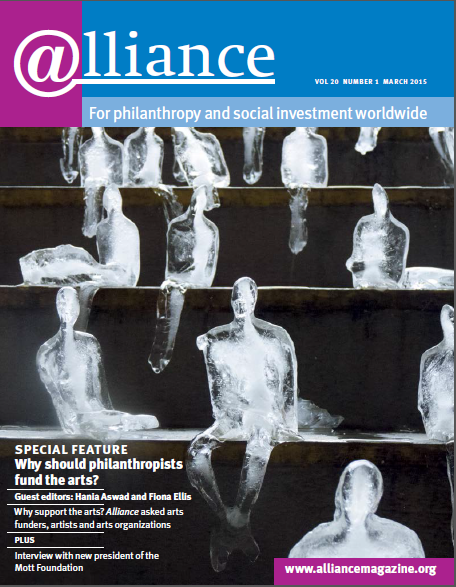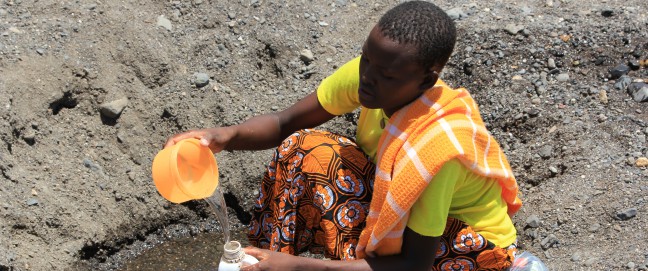Mention the words ‘sustainable development goals’ – or SDGs – outside the inner circle of UN officials, government representatives and civil society groups involved in drafting them and you are guaranteed one outcome: glazed eyes and stifled yawns. The goals are seen by many as a bureaucratic diversion from the urgent challenge of doing something practical and useful to advance sustainable development. Perhaps that’s why the philanthropic community has been so conspicuously absent from the SDG debate. But it may be time for a rethink.
It’s easy to see why the SDGs have failed to ignite philanthropic enthusiasm. An endless cycle of meetings and papers over the last four years has resulted in the UN Secretary General’s Synthesis Report on the Post-2015 Development Agenda, published on 4 December 2014. It is less of a manifesto for international action than a shopping list. The current draft of the SDGs comprises 17 goals and 169 targets ranging from the measurable to the vaguely aspirational and outright incomprehensible. Whatever your cause, there’s an SDG target for you – and the package is heading for adoption at the UN General Assembly in September 2015.
Why do the SDGs matter?
Sustainable development is the defining challenge of our generation. A billion people live in such abject poverty that survival is a struggle. Inequality is reaching increasingly obscene proportions. Environmental threats loom large: we are now on a trajectory that will lead to 4ºC warming over the course of the 21st century – an outcome that will have adverse near-term consequences for the poor and potentially catastrophic consequences for future generations. The earth’s ecological systems – forests, watersheds and biodiversity – are under growing stress. The question behind the SDG facade is this: as we head towards a global population of 9 billion, can we simultaneously eradicate poverty, curtail inequality and expand opportunity without irreparably damaging the ecosphere?
The SDGs matter in part because they define a shared global ambition and they set some high bars for achievement. Over the period to 2030 the goals envisage the eradication of extreme poverty, the elimination of avoidable child death and hunger, the provision of good-quality universal secondary education, universal access to clean water and sanitation, and access to affordable energy for all. Unlike the Millennium Development Goals (MDGs), the new goals integrate the development and environmental agendas. They extend from climate change to the sustainable management of ecological resources, and the development of safe and sustainable cities. Gender equity figures prominently.
The SDGs also explicitly aim at reducing inequality between and within countries. There is even a target for greater equity in income distribution. The SDGs call on governments to ‘progressively achieve and sustain income growth of the bottom 40 per cent of the population at a rate higher than the national average’. China, the US, Zambia, Thailand, India and the UK would all fail this test with flying colours.
In a fundamental sense the SDGs signal a change in direction. However clumsily contrived, they try to address in an integrated fashion the challenges confronting the ecosphere, the world economy and national social systems.
Why should philanthropic organizations care?
There are two compelling reasons for philanthropic organizations to engage in the SDG debate. The first is self-interest. Like them or loathe them, the way that the SDGs are interpreted and applied will influence the policy environment. As an industry that puts some $59 billion annually into financing for development, philanthropists must take seriously a process that could have a major bearing on its operating environment.
The second reason is about opportunity. Even the most fervent SDG optimist would probably acknowledge that goals, targets and intergovernmental processes do not change the world. What they can do is create the conditions to do so.
Like them or loathe them, the way that the SDGs are interpreted and applied will influence the policy environment. As an industry that puts some $59 billion annually into financing for development, philanthropists must take seriously a process that could have a major bearing on its operating environment.
The MDG experience is instructive. Some maintain that the 2015 goals ‘enabled’ the world to more than halve poverty, make deep cuts in child mortality, and move towards universal primary education and gender equity. In fact, global poverty reduction has been driven by progress in China, high-growth East Asia economies and, more recently, India – countries where the MDGs are largely irrelevant. However, the MDGs did play a role in building support for the Global Fund on HIV/AIDS, Malaria and Tuberculosis and GAVI, which has saved millions of lives through vaccination. These funds have enabled philanthropic organizations to invest in initiatives that have made a lasting impact. The MDGs also galvanized support for aid, debt relief and, perhaps more importantly, the development of innovative partnerships between governments, the private sector and civil society.
Ultimately, the SDGs will be as useful as we make them. Intergovernmental processes do not have a good track record in producing outcomes that challenge governments – and the SDG process is no different in that respect. But the goals have the potential to make a difference if philanthropic organizations take them up in the right way.
Opportunities for philanthropy
Inequality
Behind the aggregate data pointing to improvements in child mortality, school attendance, and access to water and sanitation, inequalities are widening in many countries, inequalities that will derail progress towards the 2030 goals unless governments act decisively to reduce them.
The problem is that the SDG targets do not include targets for equity. Philanthropic organizations could support civil society partners, research institutes and social activists to develop such targets, monitor progress, and develop the data sources needed to identify who is being left behind, where and by how much. In this context, I have proposed the use of ‘stepping-stone’ equity targets – interim targets for reducing inequality that will push countries towards the 2030 ambition. To take one example, how about calling on governments to halve the death rate gap between rich and poor children by 2020? Establishing that goal would provide civil society groups with a benchmark against which to hold governments to account.
Health
It is one thing to declare support for ‘leaving no one behind’. Developing the strategies needed to finance and deliver basic services such as health, education and water, and energy to the poor on affordable terms, is more difficult. We urgently need new alliances committed to the principle of progressive universalism in health – the idea that, in expanding health provision, governments should start from the bottom. This is an area in which philanthropic financing can help to build alliances for change and identify innovative solutions.
Education
Education is a priority area for development. Improved access to good-quality education – especially for women and girls – is associated with progress in virtually every dimension of human development. The SDGs envisage universal secondary schooling. Yet progress towards universal primary education has stalled with 57 million children out of school.
There is also a crisis in education quality. Around 254 million children leave school unable to read or write despite having gone through four years of education. The reasons vary from country to country. Child labour, early marriage among girls, and discrimination against ethnic minority groups are prominent factors pulling children out of education. Poor teacher training contributes to weak learning outcomes. Philanthropic engagement could make a real difference in these areas. Yet no area of development is more neglected by the philanthropic community.
Pooled funds
Grants currently suffer from many of the problems associated with aid. There are dozens of actors delivering small amounts of money with very high transaction costs. Pooled funds could be one way of overcoming this. Jeffrey Sachs, one of the architects of the SDGs, has called for the creation of expanded pooled funds in health and the creation of a global pooled fund in education. Learning from the lessons of the existing global health funds, these mechanisms could provide a vehicle for financial delivery and a focal point for philanthropic engagement.
In 2014 a new partnership was launched, the Post-2015 Partnership Platform for Philanthropy, described by Heather Grady in her article in this issue of Alliance. For philanthropic organizations interested in engaging with the SDG debate and post-2015 development processes, there could be no better place to start.
The goals are ultimately about our responsibilities towards the world’s poorest and most vulnerable people. They reflect our shared interest in peace, prosperity and a more sustainable, less unequal pattern of globalization. Our success in achieving the ambition set out in the goals will determine our children’s future. We do not live in the best of times for multilateralism. There is a paralysing lack of ambition on development and climate change. The SDGs may be a shopping list, but it’s a shopping list underpinned by the values and norms that we need to build a safer and more just world – and failure to use it will further erode the credibility of international cooperation in tackling the great challenges of the 21st century.
Kevin Watkins is executive director of the UK’s Overseas Development Institute (ODI). Email k.watkins@odi.org.uk
Lead image: Poverty and plenty live side by side in the office towers and favela of Rio de Janeiro. Photo by Adam Jones.







Comments (0)